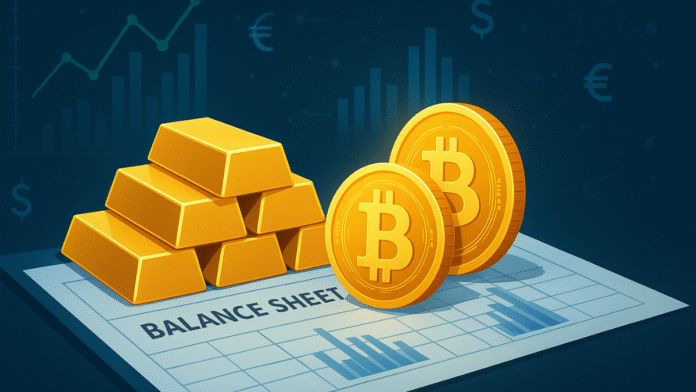The global financial world is witnessing a remarkable moment. Both gold and Bitcoin have reached new record levels this week, gaining strong momentum in 2025. Gold prices climbed close to $3,990 per ounce, while Bitcoin briefly crossed $126,000.
This surge in both assets comes as investors look for safe places to store their money. With uncertainty around the world economy, more people are turning toward assets that can protect their wealth.
A new research report from Deutsche Bank now suggests that Bitcoin, the world’s first digital currency, might soon find its way onto the balance sheets of central banks — possibly by the year 2030. This means that the same institutions that currently hold gold and foreign currencies could one day hold Bitcoin too.
According to the report, Bitcoin is becoming a more accepted and legitimate financial asset. The bank believes that as the market grows, it could stand next to gold as a “strategic reserve” — a financial tool that helps central banks protect their country’s economy.
Why Central Banks Might Hold Bitcoin
Central banks around the world hold valuable assets known as reserves. These reserves, which often include gold and foreign currencies, help countries stabilize their economies and support their national currencies.
Deutsche Bank’s new report says that Bitcoin could soon become one of those reserve assets. The bank pointed to several reasons why this shift could happen.
First, Bitcoin’s liquidity is improving. Liquidity refers to how easily something can be bought or sold without significantly affecting its price. As trading activity increases and more institutions participate, it’s becoming easier to move large amounts across the market.
Second, regulation is maturing. Around the world, governments are now creating clearer rules for cryptocurrency use. This helps reduce risks and gives more confidence to financial institutions.
Third, price volatility is declining. Volatility refers to how much the price moves up and down. Although Bitcoin is still known for its price swings, it is now more stable than it was in previous years. According to data from the Deribit Bitcoin Volatility Index, the number has dropped from 60 at the start of the year to 39 this week — showing that price movements are becoming less extreme.
The report also highlighted Bitcoin’s unique features that make it attractive for central banks. These include its limited supply, decentralized structure, portability, and accessibility. It also shows a low correlation with traditional assets such as stocks and bonds, meaning that when markets fall, it doesn’t always move in the same direction — a quality that helps balance risk.
Dollar Weakness Boosts Bitcoin and Gold Appeal
The Deutsche Bank report also discussed the weakening of the US dollar and its impact on global financial reserves. The dollar has long been considered the main “safe haven” asset for countries. However, things are changing.
The US dollar index (DXY), which measures the dollar’s strength against other major currencies, has fallen more than 9 percent since the start of the year. Economic uncertainty in the United States, including a government shutdown and trade disputes, has made investors question the dollar’s dominance.
Russia’s state-controlled crypto exchange aims to bypass SWIFT and outsmart sanctions
Over the past two decades, the dollar’s share of global reserves has dropped sharply — from 60 percent to 41 percent. Meanwhile, gold’s share has increased, as central banks buy more of the precious metal to diversify their holdings.
Now, Deutsche Bank suggests that Bitcoin might join this list of reserve assets in the future. The report says that Bitcoin and gold are both gaining importance as countries look for alternatives to the dollar.
At present, no central bank officially holds the Bitcoin as part of its reserves, though some governments possess small amounts for various purposes. Meanwhile, corporate adoption is growing rapidly. More than 200 publicly listed companies and over 60 private firms have added it to their balance sheets. Many are following the approach popularized by Michael Saylor’s company, Saylor Strategy (formerly MicroStrategy), one of the largest corporate holders worldwide.
Together, these companies now hold about 1.3 million bitcoins, worth roughly $165 billion — nearly 6 percent of the total supply.
These developments show that Bitcoin’s presence in global finance is growing. According to Deutsche Bank’s findings, its deeper liquidity, improving regulation, and lower volatility are building a stronger case for its inclusion in central bank reserves by 2030.


